Birds of Prey - Wooing the birds!
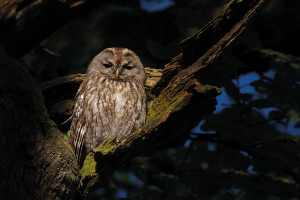
In my last article (see below), I talked about the barn owl, probably one of the UK's most recognisable birds of prey, and mentioned some of the things you can do to help. One of those was to supply boxes to offer a safe home for this wonderful bird, but there are other birds of prey that use boxes too and you might just have some of these on your golf course.
TAWNY OWL
Imagine taking a stroll through your local woodland one evening in springtime or autumn. It may be on the golf course or a local park. It's a dark, clear night and not a creature is stirring. Then, suddenly, your senses are awoken by a familiar sound, probably one of the most familiar in the British countryside - too-wit too-woo too-wit too-woo.
It is, of course, the tawny owl and, if you are lucky, you might catch a glimpse of one as it flies across a path or from tree to tree. But it is not one bird that is calling, it is in fact two; a male and female calling to each other - the female goes too-wit and the male too-woo. They are generally heard in the spring during the breeding season and again from August after the adults have finished moulting during June and July.
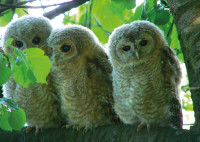
The tawny owl (or brown owl) is the most common owl in the UK and is widely distributed throughout, only being absent from some of the islands off the north and west of Scotland, the Isles of Scilly and Ireland. It has recently been added to the amber list of species of conservation concern after some contraction of its range.
It is a woodland owl, so anywhere there are trees you will probably hear one. Tawnies are very sedentary, they do not migrate and do not really move far once they have become established. They are very territorial and will defend a complete territory against a rival; there's certainly no overlapping here. They are quite a powerful bird and, with power, often comes aggression. Famous bird photographer and naturalist Eric Hosking was returning to a hide one evening (in 1937) when a tawny struck and penetrated his left eye. The resulting infection meant choosing between losing one eye or probably going blind. The eye was removed and the ensuing publicity appeared in all the national newspapers, where his photographs were already in great demand. As soon as he was fit, he returned to the hide to continue taking pictures!
The tawny owl will eat almost anything, not just what you might expect it to. Small mammals feature quite heavily in its diet, but also rats, worms, invertebrates such as beetles, small birds and even frogs. Having such a wide variety in its diet is good for its chicks and ensures a better survival rate.
It is a cavity nester and, being a woodland owl, can be found nesting in holes in mature trees, but can also utilise old crows nests or boxes (which could be perceived as replicating a tree cavity). It is a single brooded bird, nesting in early spring and usually laying eggs in March or April, but has been known to lay as early as January. It will usually lay 2-3 eggs with the female incubating them for around thirty days before hatching. One very important thing to mention is that tawny owl chicks will leave the nest before they can fly, if you find one on the ground (probably near a tree), DO NOT PICK IT UP! If the bird is in danger, then move it to a safe place nearby, the adults will be nearby and be aware of its presence.
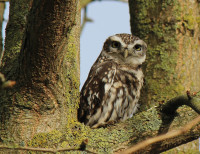
Another perhaps less familiar owl is the Little Owl, the smallest owl in the UK. This species is not a native bird of the UK. It originates from elsewhere in Europe, particularly the Mediterranean where it is sacred to the goddess Athene the virgin goddess of wisdom (perhaps that's why owls are thought of as wise) and can be found on some Greek coins. It is also found elsewhere in continental Europe.
One of the reasons for the Little Owl not getting here by natural means could be this: The UK used to be joined to mainland Europe and, at that stage, the owls hadn't reached this far. When the UK broke from the rest of Europe, the little owl stayed in Europe. There were several attempts at introduction, but none were successful until the end of the 19th century when they were introduced to parts of Northamptonshire and Kent, by wealthy landowners, to eat garden pests and have since spread to many other areas, but mainly in the south and east of the country.
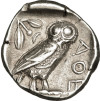
A little owl's main food source is small invertebrates such as beetles which it can find easily in habitats consisting of short grass, but it will also feed on worms, small mammals, small birds and even some plants and berries. It may be small, but the little owl is certainly a feisty bird. When approached or threatened, it will bob up and down furiously ... and humorously!
It is a small cavity nester and birds will readily take to some box designs when suitable cavities are in short supply. They lay up to six eggs, usually in April or May.
KESTREL
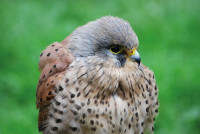
However, although the kestrel might seem like our most common bird of prey, it is on the amber list of species of conservation concern. It has been declining across its range, particularly in the north and west, but it is unclear at this stage the reasons why. One possibility is the competition for nest sites.
The kestrel is another cavity nester and will utilise holes in trees, old crows nests, buildings and cliff faces around the coast, but it also readliy take to nest boxes.
Kestrels appear all year round, but you are not necessarily seeing the same ones each time. During the winter months, some kestrels come over from Scandinavia where it gets a bit cold, whilst some UK kestrels have been known to fly as far as Spain.
It has quite a varied diet, eating worms, invertebrates, small mammals and small birds, so the young will always be catered for.
Kestrels are single brooded, laying three to four eggs on average, but possibly up to seven, although this is not common. Egg laying is usually during April and May. The chicks fledge after around four weeks, but are dependent on the adults for a short period after.
Case study at John O'Gaunt Golf Club
The nestbox project here at John O'Gaunt all started off with a box for a barn owl in 1996 but, as we had kestrels about, we thought it a good idea to put up a box for them early in 1998, just to see what happened.

Over the years, we added two more kestrel boxes, one at the opposite end of the course (which has not yet been used) and one on the Carthagena course, which was used for the first time in 2016.
During that February, I checked the box and found it to contain grey squirrels! The box was subsequently 'cleaned out' and the kestrels must have moved in straight away. They bred successfully and fledged two chicks, which was a great success.
When it comes to tawny owls, the best box I can recommend is an upright design box that must have a side inspection hatch if you are going to check it. When you open the hatch, the adult (if on the nest) can fly out the top and not into your face. We have two of boxes of this type, but they have only been used by Jackdaws so far.

On one occasion, I went to check a box as it was half hanging off a tree. I was not expecting to find anything inside but, to my surprise, I found one tawny owl chick about two or three weeks old and, very luckily, not the adult.
I suggest that, when checking any box that tawny owls might use, wear a face shield to give some protection.
We do not currently have little owls breeding on either course, but there have been two sightings in recent years, so fingers crossed they will return.
When the time comes for checking the boxes, I suggest getting in a local expert who will have the appropriate licence to be able to ring the chicks and also offer any other advice.
Not all areas of a golf course need to be cut, we can leave areas of rough/long grass in out of play areas thus providing suitable habitat for insects and small mammals and a food source for some of our protected birds. Golf courses are great places for all sorts of wildlife from small insects to large birds of prey and, if looked after and managed well, the greenkeepers of the UK can provide a bright future for all our creatures.
Contact the BTO or RSPB for more info on any of the three species I have talked about.
www.bto.org
www.rspb.org.uk
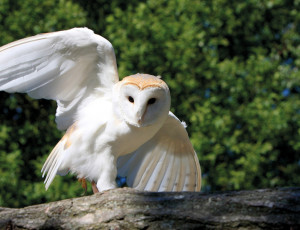
I often get asked what my favourite bird is and the answer is always the same; the silent, ghost like charismatic bird that is the barn owl.
I will never forget an experience I had on one occasion way back in 2002, early one evening, just a mile or so outside my village. I decided to go looking for a barn owl that had been seen in the area. I parked up in a lay-by and spotted the owl almost straight away quartering over a field by the side of the road. It's easy to see why they are often the victim of traffic collisions when its hunting right by the side of the road at such a low height.
I continued on foot, filming the owl with my video camera as it pounced on some prey then flew into a tree, before continuing along the roadside back and forth for several minutes, numerous times diving for prey. I watched as other cars came past quite oblivious to the beauty of nature that was right before their eyes.
I followed the owl for a while with the camera, before driving alongside it and eventually it gained height and flew further on. After another half a mile or so, at the top of a hill, I parked in a farm track to try and relocate the owl. It was just up the road a bit further. I stood by the car filming as it flew towards me, the camera slowly pointing to the sky as the owl flew straight over my head, not a sound to be heard apart from "oh my God!" from me. An experience I will not forget. But how much do you know about this silent, ghost like flyer?
The Barn Owl (Tyto alba) is one of the most widely distributed birds in the world. The Scottish population (absent from remoter Scottish islands such as the Outer Hebrides and the Northern Isles) is the most northern. It can be seen on all continents, apart from Antarctica - it takes a special type of feather to keep you warm there! There are lots of birds in Antarctica; they are just a lot more feathered than barn owls.
It can be seen throughout the UK, avoiding only high altitude and urban areas. But the British population has been in significant decline in the last century, due to several factors - changes in agricultural practices, loss of habitat and nesting sites and collisions with road traffic. In the late eighties, there were roughly 4,500 pairs of barn owl in Britain and Ireland; a quite dramatic decline from circa 12,000 in the early 1930s.
But, it's not all bad news. Since the late eighties, there has been a significant conservation effort to try and halt the decline of one of Britain's most popular birds. New habitats have been created and nestboxes have been provided. With many different conservation groups helping, the species has responded well and, although there is no formal current estimate of the population, informal estimates suggest a significant increase. This bird is here to stay.
Habitat and breeding:
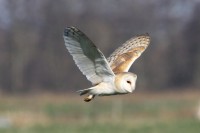
A barn owl's breeding success is dependent on the small mammal population so, as a golf course is mainly grass, it can be an ideal place to start to encourage this beautiful bird. Field voles regularly form a large part of the diet. On one occasion at John O'Gaunt Golf Club, when dissecting a barn owl pellet, we even found the remains of a water vole - the owl doesn't distinguish protected species from the common.
As the small mammal population fluctuates, so the barn owl population is up and down too. In bad years, they might not breed at all but, in good years, they can sometimes have two broods. A good year could mean a large brood; up to nine chicks have been recorded, but this is rare. An average year would probably see around four chicks, but perhaps only one or two in poor years. If they do have a second brood, this could present another problem as the chicks would be more vulnerable to bad weather later in the year, so not as likely to be as successful. In an average year, they will nest and lay eggs in the second half of April but, if they are going to have two broods, they will often lay eggs in the second half of March.
Case Study
At John O'Gaunt, way back in the early nineties when I first started, the Barn Owl was a regular sight over the tractor shed in the early morning.
In 1996, with the help of Colin Shawyer (a barn owl expert) we erected an A-frame nestbox specifically for them. They bred in the box for the first two years, but then deserted us.
There had been the odd sighting on the Carthagena course in 2008 so, in 2009, we erected another A-frame box with fresh hope they would return. But it was not for another three years (in 2012) when we had a pair nest on each course. It was a fantastic achievement for our conservation work at the club. However, it was a sad ending as, although both pairs bred with a total of five chicks, unfortunately they all died, most probably due to starvation.
2012 was a very wet year and barn owls rarely hunt in the rain so, if the adults were struggling for food, the young would eventually succumb. There was then a gap of four years but, in 2016, they nested on the Carthagena course and bred successfully, after initially laying six eggs, they had four chicks which all fledged successfully.
How long do barn owls live for?
The heaviest mortality rate is in the first year, as with most other birds small or large, but if a barn owl lives for five years it is doing well. The longest recorded time a barn owl has carried a ring for in the UK (see BTO ringing scheme) is fifteen years, making its true age possibly a bit older. Very few get over ten years but, in captivity, they can live until the ripe old age of twenty or more.
How far do they travel?
Native born British barn owls vary quite a bit in how far they travel. Some will choose not to move far from the nest site, whilst others will move up to 200km and occasionally even further. A small number of European barn owls will come to the UK when it gets too cold in their normal home.
What does the future hold and what can still be done?
Probably the most important thing is to keep the suitable habitat that supplies the food that the owls depend on. Create new habitats, improve old ones and try to ensure suitable mitigating actions if they come to be built on. Golf courses can play a vital part in the future of the barn owl by looking after their rough tussock areas.
Boxes are a way of providing a safe home for the owls, and you can never have too many. Some will be used for breeding and others for roosting in.
One very important thing to mention is that you must have a Schedule 1 Licence to be able to check a barn owl box, particularly if you suspect breeding, as the licence holder would be able to handle the adults or young for ringing purposes. The BOCN (Barn Owl Conservation Network) is a network of many volunteers across the UK who look after barn owls.
There are other owls and birds of prey that nest in boxes; tawny owl, little owl and kestrel. More about them in the next edition
If you want any advice on boxes, where to put them etc., or for more general advice then visit www.bocn.org
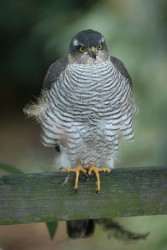
Any incident involving a bird of prey should be recorded and reported immediately.
Reporting a wildlife crime (or even a suspected wildlife crime) is important for two reasons. If the event is still happening, it may enable the authorities to catch the criminals 'in the act' (which means a higher chance of prosecution) and, if the event is over, a report can still help to build up a more accurate picture of what might be happening in a specific location or across the country as a whole.
If you witness a wildlife crime taking place (or someone is at risk of getting injured or being threatened), call 999 immediately and ask for the police. Ask to speak to a Wildlife Crime Officer and make sure to get an Incident Report number.
Do not approach suspects yourself (they may be violent or be carrying firearms).
When you call the police, try to give them information on:
• What is happening
• The exact location (a map reference or local landmark can be useful)
• Who is involved (e.g. number of people, clothing worn, tools being carried, number and breed of any dogs being used)
• The make, colour and registration number of any vehicle
• Whether or not you have photos which may be used as evidence

The police assure the public that their help is welcomed and that, if we're in any doubt that what we're seeing is a wildlife crime, we should report it anyway. Remember, if what we see 'feels' wrong, it probably is!
Even if in doubt, take a photograph and email it (at the time or later) to the police or an investigations officer - they are trained to quickly recognise when a snare is illegally placed, whether a trap is being used correctly, or whether a crime is being committed or not.
